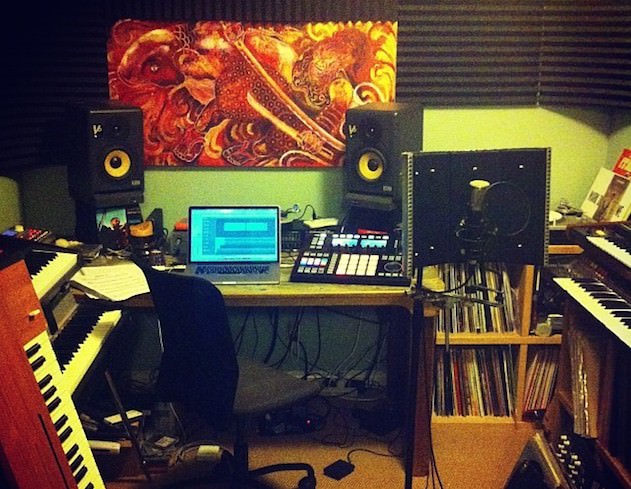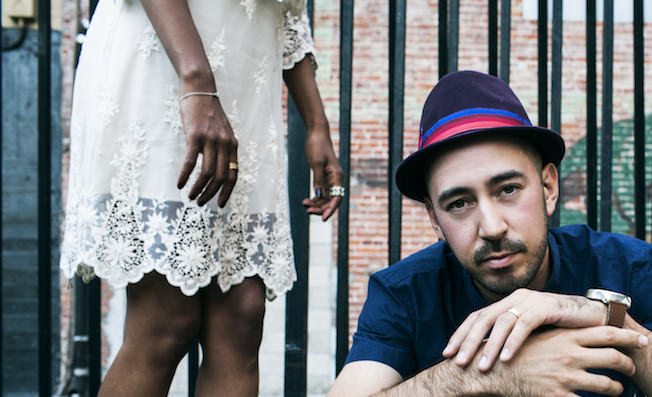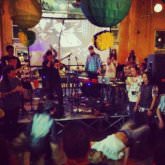
Mark’s home studio
The liner notes say you only spent two days recording in New York and one day in LA. It sounds like a very quick recording process?
Well, you know. I’m sure that Kind Of Blue and A Love Supreme didn’t take long to record…
True.
I think there’s a bit of a disconnect at the moment with artistry and mastery, whether it’s in electronic music where it’s all about laboriously making everything perfect or a band multi-tracking for weeks at a time. Let’s just play it and retain the energy of the moment. It’s so important to me.
One of the big issues in terms of making electronic music is that there’s often no distinction between the writing process and the recording or production process. You mentioned that you started again from scratch with the album concept and the demos – what happened there? Did you go back to a blank page and write new music before you went in to record?
Yeah, and that turned out to be a blessing in disguise. It had me sitting at the piano with a sheet of manuscript, composing music, and I hadn’t done that for a very long time. My general process starts on the drum machine or with samples, but having grown up as a piano player it was really beautiful to return to that and work with music on its fundamental building blocks: harmony, melody and rhythm. There’s a real integrity in the composition, to a point where I did a showcase in Japan a few weeks back where the first night was in a jazz club, we did the album trio – piano, bass, drums – and the second night was in a DJ club and I did the album solo, fully live, using Ableton and Maschine. The stylistic setting or the production aesthetic is one thing, but the composition remains paramount.
How much of a gear head do you consider yourself to be in terms of the importance you place on technology?
I love to keep up with technology and I love what it facilitates – especially with the solo live set, which is now basically built on Maschine, Kaoss Pads and Ableton. When I first started using an MPC that’s what helped me transition and bridge the gap from being a jazz piano player to being a producer. Same with the E-mu 6400. Between that and the MPC that was me.
For a while I wouldn’t touch anything digital. I’ve got a huge love for analogue and all the vintage stuff, but I was in London around 2008 and there was a studio I’d always used on days off because it had great analogue gear. I went in one day and the guy was like, ‘Oh, you’re not gonna believe it but all the keyboards are down… But don’t worry, I’ve got the Arturia stuff.’ I flew off the handle, but I’d booked a day so I went in and I made an album that day just using the MPC3000 and Arturia soft synths.
The MPC3000 helped me transition and bridge the gap from being a jazz piano player to being a producer.
Which album was that?
It was an album for an artist called Sy Smith, it’s called Fast And Curious. She’s a singer from DC. Basically the whole record was made that day except for two tracks, I think. That really turned around my whole way of thinking with soft synths. I was also a diehard MPC3000 user so it took me a long time to be open to anything else, but once I got into Maschine that really changed my workflow and changed the possibilities.
I really liked the one-take videos you did to help promote the Kickstarter. Is the setup that we saw in those videos a typical live setup for you?
Yeah, and that’s also exactly how I was set up in the studio to record the CHURCH album. Through doing this record I’ve really seen the value in adopting my live process in the studio. The way I sampled the piano in the one-take videos is the same way I sampled the horn players and the vocalists in the studio; the way I layered the elements is the same.
The timing of the videos was fortuitous with the Kickstarter. It was intended, but I’d wanted to do the videos a lot earlier. Whenever I play live there are beat heads in the front with their iPhones and you end up with videos on YouTube that are filmed badly, the sound’s really wack and it’s got your name on it, so I wanted to address that. That was the impetus behind doing it. We did the whole thing in one afternoon – I think we did three takes of each piece and just chose the best one.
To go back to what you were saying about the initial plans for the album, how different is CHURCH to the album you originally demoed?
It’s much better… [laughing]. It’s much more personal. It was actually a concept album for a label which has a lot of classic jazz back catalogue and they gave me open access to the vaults to sample anything. It was quite a formidable catalogue and the demo album was based on all this historic work, so the key difference in starting the album over was that I didn’t have the sample material and it was about starting from scratch. It gave the whole album a lot more integrity.
So from working with samples you moved to a full band setup. How did you get the personnel together?
Basically, CHURCH started as a club night about three years ago in LA then evolved between LA and New York and along with that it evolved with an LA band and a New York band. It would kind of rotate around different people, but there was a core crew, which became the core crew for these recordings.
Then I was short a trumpet player, so I was talking to Nate Smith, the drummer from New York, and he recommended Duane Eubanks straight away. I needed a trombone player and I knew of Robin Eubanks from his history anyway. ‘Oh, that’s Duane’s brother, let’s bring him in.’ There were some nice little connections there.
One of the more recent people was Low Leaf, the harp player from LA. I’d booked her for one of the CHURCH parties to open for me, then I was doing a track where the whole idea was to have a kind of Alice Coltrane meets Dilla homage joint. I thought she’d be perfect to bring her harp to the party.
Then there’s Contramestre Xingu, who’s my capoeira teacher. He plays on ‘Nova Roda’.
What’s the story behind that track?
I’ve been doing capoeira for about two and a half years now. When I’m in LA I probably do that more than music, actually. It’s an Afro-Brazilian martial art, so I love the physicality and the cultural history of it, then there’s a great musical association. When we’re fighting, or when capoeiristas are playing, we have a bateria – the music’s all provided by each other – playing pandeiro and berimbau and drums and singing Afro-Brazilian-Portuguese songs. At the same time as CHURCH was evolving we’d always have dancers and I’d also see the capoeiristas coming down and incorporating that with the dancers. Come time for the recording I wanted to capture that vibe and have it as part of the story, so I asked Xingu to come to the studio, bring the berimbau and we hit record.


09.58 AM
@MdCL
Honestly….will you be stuck forever in that Broken-Beat-Jazz-Chords-With-Rhodes-Soul thing ? Like, really ? I mean i really appreciated your music in like the 90s or whenever that was again when BB had its moment and that was cool but what about the fact it’s 2014 ? What about broadening your horizons ? Are you fooling yourself into thinking you ARE in fact developing as an artist ? Sorry, but just listening to these 2 minutes of the “now or Never” trailer makes me feel uncomfortable because it sounds like as if neo soul and jazz house were still the shit.You know, like pretending nothing new has happend in the music world in the last decade.Someone got to let you know that the Rhodes retro cult is long gone.Please.Listen to some new music.
10.36 AM
@Frank wtf are you on about…. I like his music right now in 2014. As a matter of fact Frank name some new music that is so much better. Im pretty sure your gonna get some backlash as soon as you point us at what ever music its is that you feel is so much more 2014. …… and if you say dubstep Im going to rofl.
11.37 AM
come on Frank, your trolling bro
11.47 AM
– Jesse Boykins III
– Toro y moi
– Blood Orange
– The Internet
– Soulection (basically thier whole roster)
– Junge (the band, not the genre)
– Dam Funk (70s-ish but in a modern way)
– Freddie Joachim
– Esta
– IAMNOBODI
– Machinedrum
– JMSN
– Phazz
– Jai Paul
– Sango
– Roughsoul
Just from the top of my head.Of course you might not like all or any of them, but it’s just to show you can be soul/funk/r&b influenced and still have a unique sound that doesn’t sound dated or or like stuck a decade ago.
It’s all good though, to each their own.I was just disappointed MdCL doesn’t seem to be interest to develop his sound any further.Was even at his last concert in Hamburg (Mojo Club) but that was the first time it hit me because i couldn’t believe he was doing the same thing he did 10 years ago.
12.14 PM
That’s “Jungle” of course, not “Junge”.
01.45 AM
@Frank – interesting ideas and def a little OTT. funny tho, almost every one of those artists you list considers MdCL to be a creative leader. he’s also doing a lot of different things – from soulful house to acoustic live band stuff and plenty more. just found this https://www.youtube.com/watch?v=8yup5KpnOPk – who else does full live production on the fly ?? improvised soundtrack sickness
05.28 AM
@JK
In all honesty i compiled that list not only to backup my claims (sort of) but also to provide some inspiration to MdCL should he ever come across this post (who knows).
My point:
I do acknowledge and respect his skills as a piano player as well as his undeniable abilities as a live performer especially with his unique way of building up a whole track live with the MPC, Maschine and whatnot.I always thought that was unique and i don’t deny that.
BUT:
The problem lies exactly herein, the focus on the performance / production aspect.What i mean by that is that sure it’s interesting to see how things are built up, no matter the MPC or the acoustic live band way.But that’s still just the box or the way you got there, but not the CONTENT.
The content is the MUSIC itself.You can’t substitute content with form.In other words, the music should come first, be the main focus and how you got there (through intersting things like live looping or a band or wahtever) should be a secondary matter.
Of what use is skilled jugglery with technical equipment (or piano ivories for that matter) if the music itself is just mediocre ? In the end, if the music isn’t that great, all jugglery doesn’t count.
Same problem i see with Jeremy Ellis: His NI Maschine product demos are nice flashings of his skills as a finger drummer but they tell you zilch about the actual product and his own music really is just average.Sure, you can respect him for his finger drumming, but nice technical skills doesn’t automatically equal to great music.It’s just ONE way (of many other potential ways) to get there but makes no sense if the end result (the music) doesn’t live up to your technical skills.
Uhm,,,rant over.
🙂
03.35 PM
@Frank – that’s more of a reasonable reply than your first post – now we’re getting into conversation. i see what you’re getting at but i disagree that he uses the form to substitute the content. checking out the new album and i’m just not hearing your criticism – http://www.okayplayer.com/news/mark-de-clive-lowe-church-lp-stream.html
– on Sketch for Miguel i hear a composer’s crafting. on Distractions i hear so much content AND form. loving that 🙂 oh yeah, and on Hollow i hear that rhodes you have such a problem with. but man, is it so beautiful and perfect in that context.
btw, going back to your artist list – dam funk and MdCL have collaborated – on DF’s stone’s throw album. and as for DF, he’s strictly 80s, not 70s as you noted.
personally, i’d recommend checking out MdCL with his live band 🙂 i can’t speak for the gig you said you saw but i know what i’ve seen and there’s so much music and content going on it’s mind bending